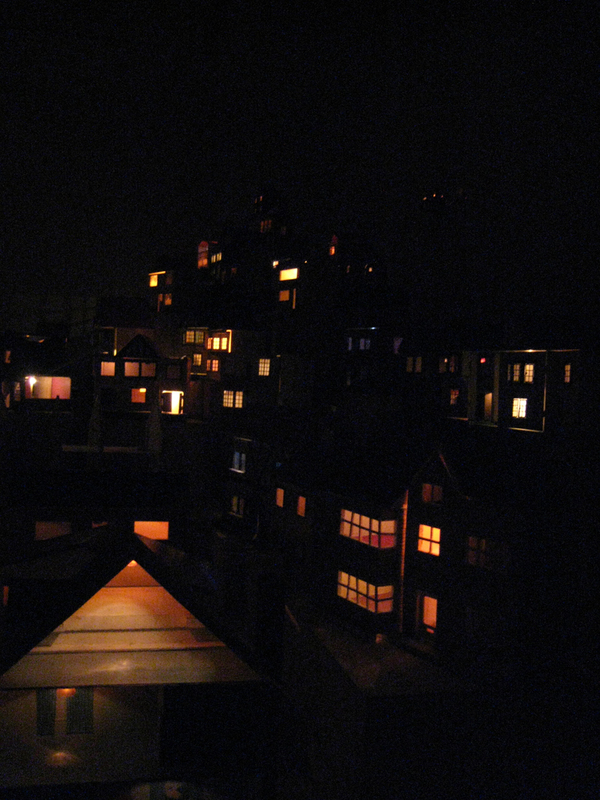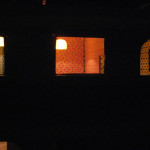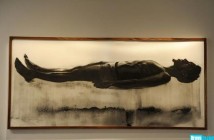RACHEL WHITEREAD @ THE MUSEUM OF FINE ARTS, BOSTON
“The house, even more than the landscape, is a ‘psychic state,’ and even when reproduced as it appears from the outside, it bespeaks intimacy.”
- Gaston Bachelard, The Poetics of Space
There comes a moment when experiencing Rachel Whiteread’s installation Place (Village) at the Museum of Fine Arts where one’s mind shifts away from the art moment and instead begins to reminisce about one’s home. This is unavoidable. Place consists of over 200 dollhouses collected by the artist. They are placed about the gallery at various heights looking very much like the village of the title. The gallery is dark with the only light coming from inside each house. It is an experience familiar to those who have stood on a rooftop at night with the town spread below. The image is so striking that wherever Place has been installed it prompts the viewer to see it as a reflection of their own personal urban/town experience. People see their homes in Whiteread’s village no matter if it is Naples, London, or Boston.
The image and feeling is quite startling when you consider the work that Whiteread is known for. The large scale casts of rooms, stairwells, and one row house have a monumentality and starkness that situated her amongst a long, well worn tradition of minimalist sculpture. Rachel Whiteread came to renown in the early nineties for her sculpture House. This piece consisted of the interior of a condemned Victorian house in London’s East End cast in concrete. It was the ultimate symbol of Whiteread’s philosophical explorations of space. Prior to this she created casts of the space under common objects (a table, a chair) as well as rooms, doors and transitional spaces (the two story stairwell). Each of these sculptures forced one to confront those liminal spaces above, between and around us. We occupy spaces without consciously thinking about how they contain or mark us psychologically. Whiteread’s early work compels us to rethink our interactions with the home. What is it about the manifestation of the emptiness of spaces that causes us to react so? To have an empty space suddenly defined and present jars one out of complacency. It is a direct confrontation with the neglected spaces of our culture.
And it is with Place that Whiteread both continues along this trajectory yet has also veered slightly. She no longer confronts us with these liminal spaces. In fact, Embankment, her final installation consisting of the interior spaces of over a thousand cardboard boxes at the Tate in London, seems to have ended this exploration. What Place does is convey the loneliness of exteriority. Here we are seeing a town devoid of life. These houses, collected over the course of twenty years, are empty yet contain memories and dreams.
Each house is distinct. They bear the marks of previous owners. Some have rugs and some have curtains. Each difference brings to mind an image of years of interaction. Some are handmade conveying a sense of intimacy. Others are stark and bare. As Whiteread remarks “the thing that really interested me in the first place was the fact that a lot of them were handmade by fathers and grandfathers, through generations. They’d gone through families and been touched by the interiors of their own houses and this was reflected in the doll’s house. You have these interesting out of scale wallpapers and carpets. All of it is genuine.” It is this genuine-ness that prompts the biggest reaction. Entering into the space you can’t help but feel the intimacy of each home. But this also provokes a disquieting feeling. The houses are in a sense abandoned. It is a very melancholic experience. In our current economic climate it is reminiscent of foreclosed homes sitting abandoned. There is an unavoidable association with failure or a collapse. The silence and emptiness of the houses leaves one feeling sad. In this way Whiteread is once again getting us to confront the loss or lack evident around us. In this sense her use of emptiness allows us to project our own fears and dreams upon the work. It allows her village to become our village. These dollhouses could be our houses. We project ourselves into them. As Marjorie Garber notes “the dollhouse provides an overview of the whole, a fantasy of control and mastery.” Whiteread has laid out a space for us to imagine ourselves. It isn’t a happy place but then again confronting absence or loss rarely is. It is for this reason that the MFA and Cheryl Brutvan should be commended for bringing this work to Boston. It is not easy nor is it simple. Like all of Whiteread’s work it looks that way but it really isn’t.
- Rachel Whiteread Place (Village), 2006-08.
- Rachel Whiteread Place (Village), 2006-08.
- Rachel Whiteread Place (Village), 2006-08.
"Rachel Whiteread: Place (Village)" is on view October 15th to January 25th, 2009 at the Museum of Fine Arts, Boston.
All images are courtesy of the author, the artist and the Museum of Fine Arts, Boston.







